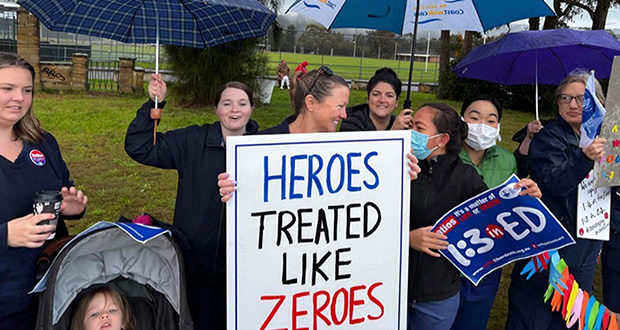For the fourth time, nurses and midwives have coloured the streets from Tweed Heads to Albury navy blue as they proudly wore their scrubs while advocating for better work conditions.
The NSWNMA's statewide 24-hour strike on September 1 came in response to the dangerous hospital staff-to-patient ratios, causing over 70 per cent of staff to feel burned out.
Nurses have been facing dramatic workforce shortages, with the need for staff projected to be a shortfall of 123,000 nurses by 2030.
"You can understand why many grassroots and rank-and-file nurses and midwives are upset," dr Greig Taylor from the UNSW Business School says.
"Always, there needs to be enough staff on hand for the number of patients, particularly if there's a surge in demand as we saw during the recent pandemic."
Yet, according to union representatives, NSWNMA's previous calls for the state to balance out the unequal staff-to-patient ratio have fallen on deaf ears.
Greig says the lack of staff is one of the underpinning bones of contention driving nurses and midwives to continue to walk off the job.
"Many healthcare workers feel pushed into a corner because their demands are not being listened to.
"And the government still hasn't given any real clarity."
Peak unions have been pushing for a 7 per cent across-the-board wage increase that's in line with inflation.
The cost of living has risen by 6.1 per cent in the 12 months to June 2022 – the fastest annual increase Australia has seen over the last 21 years.
On the back of floods and heavy rains in NSW and Queensland, crops have failed, leading to fruit and vegetables costing 5.8 per cent more than last quarter.
In the meantime, NSWNMA says the state government's raise of the public sector's wage cap by 3 per cent is not backing up against growing inflation rates.
It's estimated that nurses, paramedics, and teachers will face a real wage cut of over $7,200 every year.
The government had also offered health workers a one-off $3000 thank-you payment in June to show appreciation for their work during the pandemic, but nurses say it doesn't even come close to making up for years of wage cuts.
Greig says the pay cap is a significant issue that can burden the workforce financially if they struggle to meet basic living expenses.
"They were hailed as the heroes of the pandemic – continuing patient care under difficult, maybe even deadly circumstances.
"They were promised a pay raise.
"At the very least, they don't want to see a decrease in their real wages."
Greig says the government's chronic underinvestment in public healthcare has been a deliberate strategy.
"They pursue deliberate underfunding of healthcare services to usher in more private sector involvement," he says.
"Not only by Australia's last government but also by other governments of a similar bent, such as the UK.
"The combination of that underinvestment and macroeconomic factors, such as inflation and rising interest rates, are finally coming to a head."
Last Thursday and Friday, nurses and midwives were represented in the 2022 Jobs and Skills summit by Annie Butler from the Australian Nursing and Midwifery Federation (ANMF).
"The job summit was an opportunity for the broader union movement to push for pay rises to keep up with inflation, or at least to keep their real wages equal to what it was," Greig says.
On Friday, a long-awaited change came from the summit when home affairs minister Clare O'Neil announced the government will raise its permanent skilled migration cap to 195,000 for the current financial year.
She hopes this would help attract “thousands of nurses” into the healthcare system.
Yet, nurses and midwives are still waiting on the lift of the wage cap.
NSWNMA general secretary, Shaye Candish, says the NSW government's lack of response sends a message that nurses and midwives are not valued.
"It is a shame in this state that we must continue to demonstrate to give patients the care they deserve," Candish says.
"The longer this government stalls on adopting safe nurse-to-patient ratios, the more we'll continue to see nurses and midwives leaving the profession. We want ratios, safer workplaces and fair pay.
"It's time we caught up with the rest of the country and provided these highly skilled health professionals with the support they need to deliver the clinical care our communities deserve."
Do you have an idea for a story?Email [email protected]
 Nursing Review The latest in heathcare news for nurses
Nursing Review The latest in heathcare news for nurses

